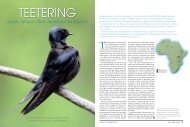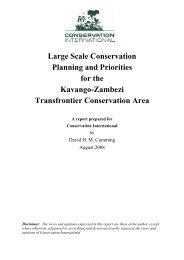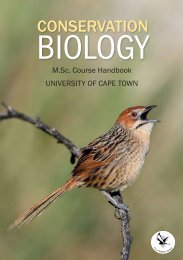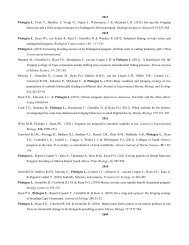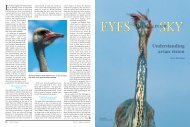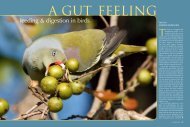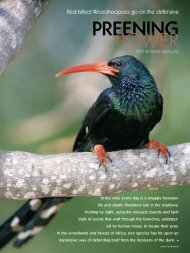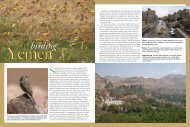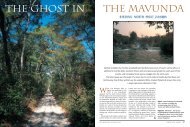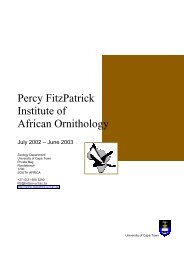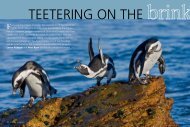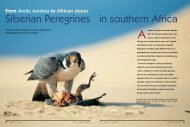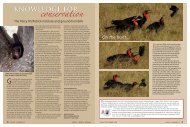The long unwinding road: birding the Tanqua Karoo
The long unwinding road: birding the Tanqua Karoo
The long unwinding road: birding the Tanqua Karoo
You also want an ePaper? Increase the reach of your titles
YUMPU automatically turns print PDFs into web optimized ePapers that Google loves.
Birding <strong>the</strong> <strong>Tanqua</strong> <strong>Karoo</strong><br />
Stretching deep into <strong>the</strong> <strong>Tanqua</strong> <strong>Karoo</strong>, <strong>the</strong> P2250 bisects<br />
a landscape that, in spring, is alive with nesting birds.<br />
Claire SPoTTiSwoode<br />
<strong>The</strong> <strong>long</strong> <strong>unwinding</strong><br />
ROAD<br />
Just two sou<strong>the</strong>rn African regions have <strong>the</strong> honour<br />
of being designated ‘bio diversity hotspots’ by Conser<br />
va tion Inter national. One is, of course, <strong>the</strong> Cape<br />
Floral Kingdom, and <strong>the</strong> o<strong>the</strong>r <strong>the</strong> Succulent <strong>Karoo</strong>.<br />
For those whose idea of <strong>the</strong> southwestern <strong>Karoo</strong> is<br />
a shimmering wasteland to be endured as briefly as<br />
possible en route to Cape Town or Johannesburg,<br />
this may come as a surprise. Though <strong>the</strong> remark<br />
able endemism and diversity of <strong>the</strong> Succulent <strong>Karoo</strong><br />
flora (at its spectacular best from August to October)<br />
is its most renowned aspect, <strong>the</strong> <strong>Karoo</strong> as a whole<br />
has a great deal to offer birders. With no fewer<br />
than 18 endemics almost wholly restricted to it, <strong>the</strong><br />
region is an essential destination for any birder visit<br />
ing sou<strong>the</strong>rn Africa, as well as a potential source of<br />
exciting new species for hardened locals.
he south-western corner of <strong>the</strong> <strong>Karoo</strong> – a lowlying,<br />
mountain-bound section of <strong>the</strong> Succulent<br />
<strong>Karoo</strong> biome known as <strong>the</strong> <strong>Tanqua</strong> <strong>Karoo</strong> after<br />
<strong>the</strong> river that bisects it – has received a great deal<br />
of <strong>birding</strong> attention. Here, in sparsely populated<br />
semi-desert just two-and-a-half hours’ drive from<br />
Cape Town, <strong>the</strong> majority of <strong>the</strong> <strong>Karoo</strong> specials are easily accessible<br />
in a day’s outing from <strong>the</strong> city.<br />
<strong>The</strong> white, dusty R355 <strong>road</strong> that stretches from <strong>Karoo</strong>poort<br />
past Eierkop to Skitterykloof (<strong>the</strong> latter popularly but incorrectly<br />
known as ‘Kat bakkies’ – <strong>the</strong> true Katbakkies Pass lies 15 kilometres<br />
to <strong>the</strong> west) has been intensively birded and well documented<br />
for birders. But <strong>the</strong> focus of this article is on some of <strong>the</strong><br />
lesser-known areas north and east of <strong>the</strong> R355, which have also<br />
proved to supply superb <strong>birding</strong>. A number of sought-after species,<br />
usually associated with <strong>the</strong> less-accessible Bushmanland<br />
region to <strong>the</strong> north and absent from or difficult to find at <strong>the</strong><br />
traditional <strong>Tanqua</strong> <strong>Karoo</strong> sites, appear to reach <strong>the</strong> south-western<br />
limit of <strong>the</strong>ir regular range here.<br />
Larks, eremomelas and <strong>the</strong> P2250<br />
For those unfamiliar with <strong>the</strong> <strong>Tanqua</strong> <strong>Karoo</strong>, <strong>the</strong> R355 regional<br />
<strong>road</strong> linking <strong>Karoo</strong>poort (at <strong>the</strong> south-westernmost corner of <strong>the</strong><br />
<strong>Tanqua</strong> <strong>Karoo</strong>) to Eierkop and Skitterykloof provides access to a<br />
alberT froneman (2)<br />
<strong>The</strong> Spike-heeled lark is one of a number of lark species that may be encountered in <strong>the</strong><br />
<strong>Tanqua</strong> <strong>Karoo</strong>.<br />
T<br />
good selection of <strong>Karoo</strong> endemics.<br />
Beyond <strong>the</strong> Skitterykloof turn-off, <strong>the</strong><br />
R355 continues northwards to Calvinia<br />
through a lonely and very beautiful<br />
stretch of semi-desert, bounded on <strong>the</strong><br />
west by <strong>the</strong> dramatic skyline of <strong>the</strong><br />
Cedarberg mountains. Conveniently,<br />
however, even day-trippers can add an<br />
attractive extra few <strong>Karoo</strong> specials and<br />
enjoy some great landscapes by continuing<br />
a more manageable distance<br />
north. Twenty-five kilometres north of<br />
<strong>the</strong> Skitterykloof turn-off, a minor <strong>road</strong>,<br />
<strong>the</strong> P2250 (1 on map), heads north-<br />
eastwards towards <strong>the</strong> distant towns of<br />
Middelpos and Su<strong>the</strong>rland.<br />
This regional <strong>road</strong> is perhaps one of<br />
<strong>the</strong> finest for <strong>birding</strong> in <strong>the</strong> south-<br />
western <strong>Karoo</strong>, particularly during <strong>the</strong><br />
spring months when <strong>the</strong> scrub is alive<br />
with displaying, nest-building and<br />
chick-provisioning birds. <strong>The</strong> initial<br />
stretches are relatively heavily vegetated<br />
and resemble <strong>the</strong> familiar R355; however,<br />
before <strong>long</strong> <strong>the</strong> bushes become<br />
spaced progressively fur<strong>the</strong>r apart.<br />
Stretches of gleaming gravel appear,<br />
punctuated by <strong>the</strong> occasional clump of<br />
spiny Hoodia, a fly-pollinated succulent<br />
decorated in spring with droopy, malodorous<br />
pink flowers. As you approach<br />
<strong>the</strong> junction marked 2 on <strong>the</strong> map, you<br />
will cross two watercourses en route to<br />
<strong>the</strong> larger <strong>Tanqua</strong> River, which break <strong>the</strong> monotony with <strong>the</strong>ir<br />
dense Acacia karroo thickets.<br />
Perhaps <strong>the</strong> most conspicuous species a<strong>long</strong> <strong>the</strong>se arid stretches<br />
is <strong>the</strong> Tractrac Chat, a gravel-plains specialist with a shorttailed,<br />
dumpy jizz. <strong>The</strong> most common bird of <strong>the</strong> adjacent scrub<br />
is usually <strong>the</strong> Rufous-eared Warbler, a noisy, beautifully marked<br />
endemic of sou<strong>the</strong>rn Africa’s arid west. Spike-heeled Larks are<br />
also often seen in <strong>the</strong>se parts, as are Thick-billed, <strong>Karoo</strong> and Redcapped<br />
larks. <strong>Karoo</strong> Lark is particularly easy to find in spring,<br />
when its rattling call is heard everywhere.<br />
<strong>The</strong> most common seedeater here is usually <strong>the</strong> Yellow<br />
Canary, but nomadic species like <strong>the</strong> Black-headed Canary and<br />
Lark-like Bunting periodically invade <strong>the</strong> area. <strong>The</strong> latter can<br />
be particularly abundant at times, and is generally present<br />
much more regularly than fur<strong>the</strong>r south in <strong>the</strong> <strong>Tanqua</strong> <strong>Karoo</strong>.<br />
Coveys of Namaqua Sandgrouse, ano<strong>the</strong>r erratic visitor fur<strong>the</strong>r<br />
south, flush up at intervals from <strong>the</strong> <strong>road</strong>side. Especially in<br />
winter and spring, Ludwig’s Bustard may be present in some<br />
numbers and is best spotted in flight, while <strong>the</strong> <strong>Karoo</strong> Korhaan<br />
occurs year-round. Pairs or small parties of <strong>the</strong> latter are occasionally<br />
seen within sight of <strong>the</strong> <strong>road</strong>, although <strong>the</strong>ir true<br />
density is only revealed at dawn when <strong>the</strong>ir atmospheric, froglike<br />
duets drift across <strong>the</strong> scrub. Greater Kestrel, scarce fur<strong>the</strong>r<br />
south in <strong>the</strong> <strong>Tanqua</strong> <strong>Karoo</strong>, is fairly regularly seen a<strong>long</strong> <strong>the</strong><br />
54 tanqua karoo<br />
africa – birds & <strong>birding</strong><br />
P2250, as are <strong>the</strong> more common<br />
Pale Chanting Goshawk<br />
and Rock Kestrel, and <strong>the</strong> occasional<br />
Black-breasted Snake Eagle<br />
and Martial Eagle.<br />
<strong>The</strong> <strong>Karoo</strong> Eremomela, a curiously<br />
localised and sometimes tricky <strong>Karoo</strong> endemic,<br />
is remarkably common a<strong>long</strong> this <strong>road</strong>. Look<br />
especially a<strong>long</strong> <strong>the</strong> shallow drain age lines four to<br />
seven kilometres from <strong>the</strong> R355 junction, and listen for its<br />
two calls (a high-pitched, pulsating whine, somewhat like <strong>the</strong><br />
tightening of a rusty bolt, and a Spike-heeled Lark-like ‘krrrkrrr’).<br />
Small groups of this social and<br />
co-operative-breeding species follow<br />
each o<strong>the</strong>r through <strong>the</strong> scrub, popping<br />
up at intervals to let forth a volley of<br />
whines.<br />
<strong>The</strong> highly nomadic Black-eared<br />
Finchlark, usually considered a Bushman<br />
land special, may well be a regular<br />
visitor to this region. In 1996, it bred in<br />
<strong>the</strong> <strong>Tanqua</strong> <strong>Karoo</strong> National Park (see<br />
Africa – Birds & Birding 2(1): 74), and in<br />
spring 2001 it invaded <strong>the</strong> <strong>Tanqua</strong><br />
<strong>Karoo</strong> once again. In this exceptional<br />
season, it occurred and probably bred<br />
right down to Eierkop at <strong>the</strong> <strong>Tanqua</strong>’s<br />
sou<strong>the</strong>rn edge; however, it was present<br />
at highest densities a<strong>long</strong> <strong>the</strong> P2250,<br />
and patchily in <strong>the</strong> <strong>Tanqua</strong> <strong>Karoo</strong><br />
National Park (see page 57).<br />
When <strong>the</strong> finchlarks are breeding,<br />
aerially displaying males are easy to<br />
locate – <strong>the</strong>y look more like giant, floppy<br />
black butterflies than birds. In flight,<br />
only <strong>the</strong>ir dangling white legs break <strong>the</strong><br />
pure black of <strong>the</strong>ir underwings and bodies.<br />
Small groups tend to land frustratingly<br />
concealed in <strong>the</strong> scrub; <strong>the</strong> best<br />
technique is to walk slowly up to <strong>the</strong><br />
spot, and wait quietly until a foraging<br />
katbakkies<br />
Pass<br />
R46<br />
Cape Town<br />
➔<br />
➔<br />
<strong>Tanqua</strong> River<br />
S w A R T R u g g e n S<br />
KLeIN<br />
CedARBeRG<br />
PRIvATe<br />
NATURe<br />
ReSeRve<br />
<strong>Tanqua</strong><br />
Guest<br />
House<br />
Calvinia<br />
TANQUA<br />
25<br />
KAROO<br />
NATIONAL<br />
PARK<br />
P2250<br />
27.6<br />
R355<br />
Skittery-<br />
klOOf<br />
Pale Chanting Goshawks are<br />
common a<strong>long</strong> <strong>the</strong> P2250.<br />
bird potters into view in a gap<br />
between <strong>the</strong> bushes.<br />
As <strong>the</strong> day heats up, or once you<br />
have exhausted <strong>the</strong> possibilities of <strong>the</strong><br />
gravel plains and scrub, you may wish to<br />
make a stop at <strong>the</strong> first or especially <strong>the</strong><br />
second Acacia-lined watercourse, <strong>the</strong> latter<br />
crossing <strong>the</strong> P2250 27.6 kilometres from <strong>the</strong><br />
R355. Here you have a good chance of find- <br />
april/may 2002 tanqua karoo<br />
38 km<br />
<strong>Tanqua</strong> River<br />
Ongeluks Rivier<br />
eierkop<br />
karOOPOOrt<br />
R46<br />
T A N Q U A K A R O O<br />
Onder-<br />
Wadrif<br />
R356<br />
N1<br />
Bo-Wadrif<br />
Touwsrivier<br />
Ouberg Pass<br />
➔<br />
Calvinia<br />
R O g g e v e l d m O u n T A i n S<br />
R354<br />
R354<br />
➔<br />
Williston<br />
Su<strong>the</strong>rland<br />
Beaufort<br />
West<br />
➔<br />
Matjiesfontein<br />
55
Traditionally regarded as a bushmanland species, <strong>the</strong> nomadic black-eared finchlark<br />
appears to be venturing south into <strong>the</strong> <strong>Tanqua</strong> <strong>Karoo</strong> on a regular basis.<br />
ing all <strong>the</strong> expected <strong>Karoo</strong> thicket species, such as Pririt Batis,<br />
Cape Penduline Tit (also in <strong>the</strong> adjacent lower scrub), Titbabbler<br />
and White-backed Mousebird. Just beyond <strong>the</strong> second watercourse<br />
a turn-off to <strong>the</strong> left, signposted ‘<strong>Tanqua</strong>’ and marked 2 on<br />
<strong>the</strong> map, takes you 12 kilometres fur<strong>the</strong>r to <strong>the</strong> <strong>Tanqua</strong> River and<br />
to <strong>the</strong> <strong>Tanqua</strong> Guest House nearby (3 on map; see box, page 59).<br />
<strong>The</strong> <strong>Tanqua</strong> Guest House makes an excellent base for exploring<br />
this area and <strong>the</strong> adjacent national park; however, <strong>the</strong> river does<br />
lie on private land, so if you wish to visit for <strong>the</strong> day please obtain<br />
prior permission from <strong>the</strong> landowners, Alewyn and Es<strong>the</strong>r<br />
Burger.<br />
PeTer STeyn<br />
alberT froneman<br />
<strong>The</strong> dusky Sunbird, ano<strong>the</strong>r nomadic species, may be seen in riparian vegetation.<br />
<strong>The</strong> Namaqua Warbler, which in this region occasionally also<br />
occurs in acacia thickets far from water, is very common and<br />
fairly easily seen in <strong>the</strong> mixture of reeds and acacia thicket that<br />
densely lines <strong>the</strong> <strong>Tanqua</strong> River. This riparian strip is also one of<br />
<strong>the</strong> more reliable sites in <strong>the</strong> area to look for <strong>the</strong> Dusky Sunbird,<br />
a highly nomadic desert sunbird that only occasionally ventures<br />
south to <strong>the</strong> Eierkop–Skitterykloof region. <strong>The</strong> <strong>Tanqua</strong> River is<br />
dammed just beyond <strong>the</strong> guest house, ra<strong>the</strong>r startlingly creating<br />
a substantial waterbody that hosts varying numbers of water -<br />
fowl and waders, perhaps most characteristically South African<br />
Shelduck and Avocet.<br />
56 tanqua karoo africa – birds & <strong>birding</strong><br />
a sense of enormous space is a prime attraction of <strong>the</strong> <strong>Tanqua</strong> <strong>Karoo</strong> national Park.<br />
<strong>Tanqua</strong> <strong>Karoo</strong> National Park<br />
<strong>The</strong> <strong>Tanqua</strong> <strong>Karoo</strong> National Park is designated a Scientific<br />
National Park and as such offers no visitor facilities. As a rule it<br />
is not open to <strong>the</strong> public, but through direct contact with <strong>the</strong><br />
park management special entry permission can be requested.<br />
<strong>The</strong> park protects one of <strong>the</strong> most starkly beautiful tracts of <strong>the</strong><br />
<strong>Tanqua</strong> <strong>Karoo</strong> and is well worth visiting for several reasons,<br />
among <strong>the</strong>m its koppie-studded, moon-like landscape, its diversity<br />
of succulent plants, its fine <strong>Karoo</strong> <strong>birding</strong> and, perhaps most<br />
notably for hardened birders, <strong>the</strong> above-average chance of finding<br />
<strong>the</strong> enigmatic Burchell’s Courser.<br />
Claire SPoTTiSwoode<br />
<strong>The</strong> park is criss-crossed by a number of vehicle tracks, most of<br />
which are easily negotiated by two-wheel-drive. <strong>The</strong> park’s management<br />
currently welcomes visitors, on <strong>the</strong> understanding that<br />
no facilities are provided and that prior permission is obtained<br />
(see box on page 59 for contact details). However, don’t let<br />
courser-ambition get <strong>the</strong> better of you, because should <strong>the</strong> presence<br />
of any birders result in any potentially negative impact on<br />
<strong>the</strong> park, such access may become restricted in <strong>the</strong> future.<br />
Birders will probably want to concentrate <strong>the</strong>ir efforts a<strong>long</strong><br />
<strong>the</strong> track that runs parallel to <strong>the</strong> park’s sou<strong>the</strong>rn boundary and<br />
is easily accessible from <strong>the</strong> <strong>Tanqua</strong> Guest House. Burchell’s <br />
april/may 2002 tanqua karoo<br />
57
Courser is seen fairly regularly on <strong>the</strong> patches of bare gravel<br />
a<strong>long</strong> this <strong>road</strong>, and was even observed with chicks in spring<br />
2001. This courser is a poorly known and notoriously tricky bird:<br />
it may be absent altoge<strong>the</strong>r in some years, and even when<br />
present requires considerable effort to spot. <strong>The</strong> best techniques<br />
are to drive a<strong>long</strong> slowly, stopping now and <strong>the</strong>n to scan promising-looking<br />
expanses of gravel, and to keep a very sharp eye<br />
out for odd-shaped birds flying overhead. We have<br />
picked up most of <strong>the</strong> coursers we<br />
have seen in <strong>the</strong> park this way.<br />
Double-banded Courser<br />
also occurs here. A bird<br />
that appears to reach<br />
<strong>the</strong> sou<strong>the</strong>rn limit of<br />
its regular range in<br />
this part of <strong>the</strong><br />
<strong>Tanqua</strong> <strong>Karoo</strong><br />
is <strong>the</strong> <strong>Karoo</strong> Long-billed Lark, which becomes very much more<br />
common as one enters Bushmanland to <strong>the</strong> north.<br />
Ouberg Pass and on to Su<strong>the</strong>rland<br />
Heading eastwards from <strong>the</strong> <strong>Tanqua</strong> <strong>Karoo</strong> National Park, a<br />
potentially confusing network of <strong>road</strong>s works its way over <strong>the</strong><br />
Roggeveld escarpment and on to <strong>the</strong> town of Su<strong>the</strong>rland, whose<br />
one-horse appearance belies its astronomical fame. <strong>The</strong> new<br />
Sou<strong>the</strong>rn African Large Telescope is presently under construction<br />
here, and when complete will be <strong>the</strong> largest single telescope<br />
in <strong>the</strong> sou<strong>the</strong>rn hemisphere.<br />
<strong>The</strong>se are beautiful, remote <strong>road</strong>s, worth driving for <strong>the</strong>ir solitude<br />
and landscapes alone. However, if a <strong>birding</strong> objective is<br />
more important, <strong>the</strong>n Ouberg Pass (4 on map) also fits <strong>the</strong> bill<br />
admirably. Ouberg is a truly spectacular pass, rising precipitously<br />
through 600 metres of Roggeveld escarpment in a series of<br />
dramatic switchbacks that may not appeal to <strong>the</strong> particularly<br />
faint-hearted. <strong>The</strong> rewards are superb views of <strong>the</strong> great, hazy<br />
basin of <strong>the</strong> <strong>Tanqua</strong> <strong>Karoo</strong> below, and excellent <strong>birding</strong>.<br />
Ouberg Pass is possibly <strong>the</strong> most reliable place within striking<br />
distance of Cape Town to see Rock Pipit (knowledge of its call is<br />
essential), and is also a good site for o<strong>the</strong>r <strong>Karoo</strong> escarpment<br />
birds such as Sickle-winged Chat, Pale-winged Starling and,<br />
toge<strong>the</strong>r with <strong>the</strong> plateau beyond, Cape Eagle Owl. <strong>The</strong> latter<br />
can be looked for at any time from dusk onwards, simply by<br />
scanning <strong>the</strong> <strong>road</strong>side telephone poles. Cape Eagle Owls can be<br />
unexpectedly common in many mountainous <strong>Karoo</strong> regions<br />
(see also Klein Cedarberg Private Nature Reserve, in box opposite),<br />
although do be aware of <strong>the</strong> occasional Spotted Eagle Owl<br />
that may venture out of a copse of exotic trees.<br />
<br />
africa – birds & <strong>birding</strong><br />
WheN TO visiT<br />
Spring is best: <strong>birding</strong> is at its peak from August to October, when <strong>the</strong><br />
region may also unpredictably burst into flower. However, with a little<br />
effort <strong>the</strong> majority of <strong>the</strong> specials (with <strong>the</strong> possible exception of Blackheaded<br />
Canary, Ludwig’s Bustard and Black-eared Finchlark) are accessible<br />
year-round.<br />
iTiNeRARies & AppROAches<br />
If you are approaching <strong>the</strong> <strong>Tanqua</strong> <strong>Karoo</strong> from Cape Town, you will find<br />
that although it is certainly possible to visit <strong>the</strong> areas described here in a<br />
(<strong>long</strong>) day trip, this really requires a desperately early start. Making a<br />
weekend of it is far preferable!<br />
<strong>The</strong> R355/P2250 junction is 103 kilometres from Ceres, and takes more<br />
than three hours to reach from Cape Town. Coming from <strong>the</strong> east, an<br />
attractive option is to work your way down into <strong>the</strong> <strong>Tanqua</strong> <strong>Karoo</strong> over<br />
<strong>the</strong> Ouberg Pass, having first turned off <strong>the</strong> N1 on to <strong>the</strong> tarred R354<br />
towards Su<strong>the</strong>rland.<br />
<strong>The</strong> <strong>Tanqua</strong> <strong>Karoo</strong> also makes an excellent start to a Bushmanland trip:<br />
<strong>the</strong> R355 can be followed north all <strong>the</strong> way to Calvinia. <strong>The</strong> <strong>road</strong> surface<br />
is generally excellent and <strong>the</strong> scenery superb, but make sure that you’re<br />
adequately prepared for <strong>the</strong> lonely drive...<br />
ROAds<br />
Take care when driving in this region – <strong>the</strong> <strong>road</strong> gravel is sharp and often<br />
loose, and a great deal of caution needs to be taken with corners and<br />
sudden stops. Fur<strong>the</strong>rmore, give some thought to your fuel and water<br />
requirements, bearing in mind that <strong>the</strong>re are no towns in <strong>the</strong> <strong>Tanqua</strong><br />
<strong>Karoo</strong> proper, and <strong>the</strong> closest refuelling points are Ceres, Su<strong>the</strong>rland and<br />
Calvinia. Those with thirsty engines may consider packing a (full) jerrycan<br />
to guard against potential concerns over <strong>birding</strong> detours.<br />
OFF YOU GO...<br />
<strong>The</strong> <strong>Tanqua</strong> <strong>Karoo</strong> national Park offers a reasonable chance of seeing <strong>the</strong> elusive burchell’s Courser. Superb views of <strong>the</strong> roggeveld mountains – and good <strong>birding</strong> – are to be had a<strong>long</strong> <strong>the</strong> ouberg Pass.<br />
lark-like buntings are<br />
more common in <strong>the</strong><br />
nor<strong>the</strong>rn <strong>Tanqua</strong> <strong>Karoo</strong><br />
than in <strong>the</strong> south.<br />
alberT froneman<br />
Callan Cohen<br />
Claire SPoTTiSwoode<br />
WheRe TO sTAy<br />
klein Cedarberg Private Nature reserve<br />
A visit to Klein Cedarberg is an experience in itself, quite apart from its<br />
beautiful location in <strong>the</strong> Koue Bokkeveld region, west of Skitterykloof and<br />
not far from <strong>the</strong> true Katbakkies Pass. <strong>Karoo</strong> cuisine, Cedarberg architecture<br />
and <strong>the</strong> hospitality of <strong>the</strong> Wullschleger family combine with nearby<br />
Bushman rock art, excellent potential for night drives (notably for Cape<br />
eagle Owl, but don’t ignore Smith’s red rock rabbit, rhebok and maybe<br />
even a leopard) and ideal proximity to <strong>birding</strong> at Skitterykloof.<br />
Tel. (023) 317 0783 or see www.cape<strong>birding</strong>route.org<br />
tanqua Guest House<br />
<strong>The</strong> <strong>Tanqua</strong> Guest House is very conveniently situated in good <strong>birding</strong><br />
habitat on <strong>the</strong> sou<strong>the</strong>rn bank of <strong>the</strong> <strong>Tanqua</strong> River, no more than a stone’s<br />
throw from <strong>the</strong> <strong>Tanqua</strong> <strong>Karoo</strong> National Park. Built somewhat like a desert<br />
fort and catering primarily to small-plane enthusiasts, <strong>the</strong> <strong>Tanqua</strong> Guest<br />
House is run by es<strong>the</strong>r and Alewyn Burger and offers a range of accommodation,<br />
from fully catered to self-catering to a rustic ‘hunting lodge’.<br />
<strong>The</strong> Burgers are also able to arrange access to <strong>the</strong> national park for <strong>the</strong>ir<br />
guests. Tel. (027) 341 2366 or see www.cape<strong>birding</strong>route.org<br />
TANQUA KAROO NATiONAL pARK<br />
In order to gain permission to enter <strong>the</strong> park, contact park management<br />
on tel. (027) 341 2352.<br />
FUR<strong>The</strong>R ReAdiNg<br />
For a more detailed description of <strong>birding</strong> in <strong>the</strong> sou<strong>the</strong>rly reaches of <strong>the</strong><br />
<strong>Tanqua</strong>, visit www.cape<strong>birding</strong>route.org or obtain a copy of <strong>the</strong> authors’<br />
book essential Birding in Western South africa: key routes from Cape town<br />
to <strong>the</strong> kalahari (Struik, 2000).<br />
april/may 2002 tanqua karoo<br />
59



